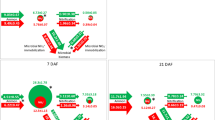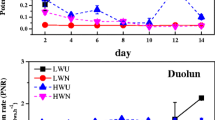Abstract
Biological nitrification inhibition (BNI) has been considered a plant strategy to increase N use efficiency by reducing N losses via N2O emissions or nitrate leaching. However, recent studies have revealed no difference in gross nitrate production among Urochloa humidicola genotypes with previously described high- and low-BNI capacity and pointed towards a crucial role for microbial N immobilization. In the current greenhouse study, we compared the 15 N acquisition by two U. humidicola genotypes (with high- and low-BNI capacity) and their soil-associated microorganisms at four points in time after fertilization (50 kg N ha−1). Soil microorganisms slightly out-competed both genotypes during the first 24 h after fertilization, and microorganisms associated with high-BNI genotype immobilized more N than microbes associated with low-BNI plants. Nevertheless, by the end of the experiment, low-BNI plant genotype had acquired more 15 N, despite higher to N2O emissions. Furthermore, higher 15 N root-to-shoot transfer was observed in low-BNI plants, potentially indicating higher contribution of nitrate to plant N uptake. In conclusion, our results confirm higher importance of microbial N immobilization in high-BNI genotypes, at least in the short-term. However, this did not result in higher N uptake by the high BNI genotype during the first 3 weeks after fertilization as could be expected. Long-term field studies are required to better understand the implications of direct (BNI sensu stricto) and indirect mechanisms (including differences in rhizosphere microbial biomass, activity and composition between high- and low-BNI genotypes), processes on plant N use efficiency, N storage in soil, and N losses to the environment.



Similar content being viewed by others
References
Abalos D, Jeffery S, Sanz-Cobena A, Guardia G, Vallejo A (2014) Meta-analysis of the effect of urease and nitrification inhibitors on crop productivity and nitrogen use efficiency. Agr Ecosyst Environ 189:136–144. https://doi.org/10.1016/J.AGEE.2014.03.036
Arango J, Moreta D, Núñez J, Hartmann K, Domínguez M, Ishitani M, Miles J, Subbarato G, Peters M, Rao I (2014) Developing methods to evaluate phenotypic variability in biological nitrification inhibition (BNI) capacity of Brachiaria grasses. Tropical Grasslands - Forrajes Tropicales 2:6. https://doi.org/10.17138/TGFT(2)6-8
Bardgett RD, Streeter TC, Bol R (2003) Soil microbes compete effectively with plants for organic-nitrogen inputs to temperate grasslands. Ecology 84:1277–1287. https://doi.org/10.1890/0012-9658(2003)084[1277:Smcewp]2.0.Co;2
Brookes PC, Landman A, Pruden G, Jenkinson DS (1985) Chloroform fumigation and the release of soil nitrogen: a rapid direct extraction method to measure microbial biomass nitrogen in soil. Soil Biol Biochem 17:837–842. https://doi.org/10.1016/0038-0717(85)90144-0
Byrnes RC, Núñez J, Arenas L, Rao I, Trujillo C, Álvarez C, Arango J, Rasche F, Chirinda N (2017) Biological nitrification inhibition by Brachiaria grasses mitigates soil nitrous oxide emissions from bovine urine patches. Soil Biol Biochem 107:156–163. https://doi.org/10.1016/J.SOILBIO.2016.12.029
Cabrera ML, Beare MH (1993) Alkaline persulfate oxidation for determining total nitrogen in microbial biomass extracts. Soil Sci Soc Am J 57:1007–1012. https://doi.org/10.2136/SSSAJ1993.03615995005700040021X
Cantarel AAM, Pommier T, Desclos-Theveniau M, Diquéloiu S, Dumont M, Grassein F, Kastl EM, Grigulis K, Laine P, Lavorel S, Lemauviel-Lanenant S, Personeni E, Schloter M, Poly F (2015) Using plant traits to explain plant–microbe relationships involved in nitrogen acquisition. Ecology 96:788–799. https://doi.org/10.1890/13-2107.1
Cavagnaro TR, Bender SF, Asghari HR, van der Heijden MGA (2015) The role of arbuscular mycorrhizas in reducing soil nutrient loss. Trends Plant Sci 20:283–290. https://doi.org/10.1016/j.tplants.2015.03.004
Dunn RM, Mikola J, Bol R, Bardgett RD (2006) Influence of microbial activity on plant-microbial competition for organic and inorganic nitrogen. Plant Soil 289:321–334. https://doi.org/10.1007/s11104-006-9142-z
Hachiya T, Sakakibara H (2017) Interactions between nitrate and ammonium in their uptake, allocation, assimilation, and signaling in plants. J Exp Bot 68:2501–2512. https://doi.org/10.1093/JXB/ERW449
Harrison KA, Bol R, Bardgett RD (2007) Preferences for different nitrogen forms by coexisting plant species and soil microbes. Ecology 88:989–999. https://doi.org/10.1890/06-1018
Hodge A, Robinson D, Fitter A (2000) Are microorganisms more effective than plants at competing for nitrogen? Trends Plant Sci 5:304–308. https://doi.org/10.1016/S1360-1385(00)01656-3
Horrocks CA, Arango J, Arevalo A, Nuñez J, Cardoso JA, Dungait JAJ (2019) Smart forage selection could significantly improve soil health in the tropics. Sci Total Environ 688:609–621. https://doi.org/10.1016/J.SCITOTENV.2019.06.152
Innes L, Hobbs PJ, Bardgett RD (2004) The impacts of individual plant species on rhizosphere microbial communities in soils of different fertility. Biol Fert Soils 40:7–13. https://doi.org/10.1007/s00374-004-0748-0
Inselsbacher E, Hinko-Najera Umana N, Stange FC, Gorfer M, Schüller E, Ripka K, Zechmeister-Boltenstern S, Hood-Novotny R, Strauss J, Wanek W (2010) Short-term competition between crop plants and soil microbes for inorganic N fertilizer. Soil Biol Biochem 42:360–372. https://doi.org/10.1016/J.SOILBIO.2009.11.019
Jackson LE, Schimel JP, Firestone MK (1989) Short-term partitioning of ammonium and nitrate between plants and microbes in an annual grassland. Soil Biol Biochem 21:409–415. https://doi.org/10.1016/0038-0717(89)90152-1
Joergensen RG (1996) The fumigation-extraction method to estimate soil microbial biomass: calibration of the kEC value. Soil Biol Biochem 28:25–31. https://doi.org/10.1016/0038-0717(95)00102-6
Karwat H, Moreta D, Arango J, Nuñez J, Rao I, Rincón A, Rasche F, Cadish G (2017) Residual effect of BNI by Brachiaria humidicola pasture on nitrogen recovery and grain yield of subsequent maize. Plant Soil 420:389–406. https://doi.org/10.1007/S11104-017-3381-Z/TABLES/3
Karwat H, Sparke M, Rasche F, Arango J, Nuñez J, Rao I, Moreta D, Cadish G (2019) Nitrate reductase activity in leaves as a plant physiological indicator of in vivo biological nitrification inhibition by Brachiaria humidicola. Plant Physiol Bioch 137:113–120. https://doi.org/10.1016/J.PLAPHY.2019.02.002
Kaye JP, Hart SC (1997) Competition for nitrogen between plants and soil microorganisms. Trends Ecol Evol 12:139–143. https://doi.org/10.1016/S0169-5347(97)01001-X
Kowalchuk GA, Buma DS, De Boer W, Klinkhamer PGL, van Veen J (2002) Effects of above-ground plant species composition and diversity on the diversity of soil-borne microorganisms. Anton Van Lee J M S 81:509–520. https://doi.org/10.1023/A:1020565523615
Kronzucker HJ, Siddiqi MY, Glass ADM, Kirk GJD (1999) Nitrate-ammonium synergism in rice. A Subcellular Flux Analysis Plant Physiol 119:1041–1046. https://doi.org/10.1104/PP.119.3.1041
Kuzyakov Y, Xu X (2013) Competition between roots and microorganisms for nitrogen: mechanisms and ecological relevance. New Phytol 198:656–669. https://doi.org/10.1111/NPH.12235
Lipson D, Näsholm T (2001) The unexpected versatility of plants: organic nitrogen use and availability in terrestrial ecosystems. Oecologia 128:305–316
Liu Q, Qiao N, Xu X, Xin X, Han JY, Tian Y, Ouyang H, Kuzyakov Y (2016) Nitrogen acquisition by plants and microorganisms in a temperate grassland. Sci Rep 6:22642. https://doi.org/10.1038/srep22642
Nakamura S, Saliou PS, Takahashi M, Ando Y, Subbarao GV (2020) The contribution of root turnover on biological nitrification inhibition and its impact on the ammonia-oxidizing Archaea under Brachiaria cultivations. Agronomy 10:1003. https://doi.org/10.3390/AGRONOMY10071003
Nuñez J, Arevalo A, Karwat H, Egenolf K, Miles J, Chirinda N, Cadish G, Rasche F, Rao I, Subbarao G, Arango J (2018) Biological nitrification inhibition activity in a soil-grown biparental population of the forage grass, Brachiaria humidicola. Plant Soil 426:401–411. https://doi.org/10.1007/s11104-018-3626-5
Porazinska DL, Bardgett RD, Blaauw MB, Hunt W, Parsons A, Seastedt R, Wall D (2003) Relationships at the aboveground-belowground interface: plants, soil biota, and soil processes. Ecol Monogr 73:377–395. https://doi.org/10.1890/0012-9615(2003)073[0377:RATAIP]2.0.CO;2
Raven JA, Smith FA (1976) Nitrogen assimilation and transport in vascular land plants in relation to intracellular pH regulation. New Phytol 76:415–431. https://doi.org/10.1111/J.1469-8137.1976.TB01477.X
Robarge WP, Edwards A, Johnson B (2008) Water and waste water analysis for nitrate via nitration of salicylic acid 1. Commun Soil Sci Plant Anal 14:1207–1215. https://doi.org/10.1080/00103628309367444
Schobert C, Komor E (1990) Transfer of amino acids and nitrate from the roots into the xylem of Ricinus communis seedlings. Planta 181:1 181:85–90. https://doi.org/10.1007/BF00202328
Subbarao GV, Yoshihashi T, Worthington M, Nakahara K, Ando Y, Sahrawat KL, Rao IM, Lata JC, Kishii M, Braun HJ (2015) Suppression of soil nitrification by plants. Plant Sci 233:155–164. https://doi.org/10.1016/J.PLANTSCI.2015.01.012
Subbarao GV, Nakahara K, Hurtado MP, Ono H, Moreta DE, Salcedo AF, Yoshihashi AT, Ishikawa T, Ishitani M, Ohnishi-Kameyama M, Yoshida M, Rondon M, Rao IM, Lascano CE, Berry WL, Ito O (2009) Evidence for biological nitrification inhibition in Brachiaria pastures. PNAS 106:17302–17307. https://doi.org/10.1073/PNAS.0903694106
Subbarao GV, Sahrawat KL, Nakahara K, Ishikawa T, Kishii M, Rao IM, Hash CT, Geroge TS, Rao PS, Nardi P, Bonnett D, Berry W, Suenaga K, Lata JC (2012) Biological nitrification inhibition-a novel strategy to regulate nitrification in agricultural systems. Adv Agron 114:249–302. https://doi.org/10.1016/B978-0-12-394275-3.00001-8
Subbarao GV, Searchinger TD (2021) Opinion: A “more ammonium solution” to mitigate nitrogen pollution and boost crop yields. Proc Natl Acad Sci 118:2107576118. https://doi.org/10.1073/PNAS.2107576118
Subbarao GV, Wang HY, Ito O, Nakahara K, Berry WL (2007) NH4+ triggers the synthesis and release of biological nitrification inhibition compounds in Brachiaria humidicola roots. Plant Soil 290:245–257. https://doi.org/10.1007/S11104-006-9156-6/FIGURES/4
Sylvester-Bradley R, Mosquera D, Méndez JE (1988) Inhibition of nitrate accumulation in tropical grassland soils: effect of nitrogen fertilization and soil disturbance. J Soil Sci 39:407–416. https://doi.org/10.1111/J.1365-2389.1988.TB01226.X
Tang C, Rengel Z (2003) Role of plant cation/anion uptake ratio in soil acidification. In: Rengel Z (ed) Handbook of soil Acidity, 1s edn. CRC Press, Boca Ratón, pp 71–96
Teutscherova N, Vazquez E, Arevalo A, Pulleman M, Rao I, Arango J (2019) Differences in arbuscular mycorrhizal colonization and P acquisition between genotypes of the tropical Brachiaria grasses: is there a relation with BNI activity? Biol Fert Soils 55:325–337. https://doi.org/10.1007/s00374-019-01353-y
Teutscherova N, Vazquez E, Masaguer A, Navas M, Scow KM, Schmidt R, Benito M (2017) Comparison of lime- and biochar-mediated pH changes in nitrification and ammonia oxidizers in degraded acid soil. Biol Fert Soils 53:811–821. https://doi.org/10.1007/s00374-017-1222-0
Teutscherová N, Vázquez E, Sotelo M, Villegas D, Velásquez N, Baquero D, Pulleman M, Arango J (2021a) Intensive short-duration rotational grazing is associated with improved soil quality within one year after establishment in Colombia. Appl Soil Ecol 159:103835. https://doi.org/10.1016/j.apsoil.2020.103835
Teutscherová N, Vázquez E, Trubač J, Villegas DM, Subbarao GV, Pulleman M, Arango J (2021b) Gross N transformation rates in soil system with contrasting Urochloa genotypes do not confirm the relevance of BNI as previously assessed in vitro. Biol Fert Soils. https://doi.org/10.1007/S00374-021-01610-Z/TABLES/2
Vance ED, Brookes PC, Jenkinson DS (1987) An extraction method for measuring soil microbial biomass C. Soil Biol Biochem 19:703–707. https://doi.org/10.1016/0038-0717(87)90052-6
Vázquez E, Teutscherova N, Dannenmann M, Töchterle P, Butterbach-Bahl K, Pulleman M, Arango J (2020) Gross nitrogen transformations in tropical pasture soils as affected by Urochloa genotypes differing in biological nitrification inhibition (BNI) capacity. Soil Biol Biochem 151:108058. https://doi.org/10.1016/J.SOILBIO.2020.108058
Xu X, Ouyang H, Richter A, Wanek W, Cao G, Kuzyakov Y (2011) Spatio-temporal variations determine plant-microbe competition for inorganic nitrogen in an alpine meadow. J Ecol 99:563–571. https://doi.org/10.1111/j.1365-2745.2010.01789.x
Acknowledgements
We are grateful to the stable isotope laboratory of BayCEER for performing the isotope analyses.
Funding
Financial support was also obtained from the Internal Grant Agency of Czech University of Life Sciences Prague (20213110). This work was partly supported the One CGIAR Initiative on Livestock, System and Climate Resilience (LCSR). We received funding from BBSRC project grants RCUK-CIAT Newton Fund—Advancing sustainable forage-based livestock production systems in Colombia (CoForLife) (BB/S01893X/1) and the UKRI Global Challenges Research Fund (GCRF) GROW Colombia grant via the UK’s BBSRC (BB/P028098/1).
Author information
Authors and Affiliations
Corresponding authors
Ethics declarations
Conflict of interest
The authors declare no competing interests.
Additional information
Publisher's Note
Springer Nature remains neutral with regard to jurisdictional claims in published maps and institutional affiliations.
Supplementary Information
Below is the link to the electronic supplementary material.
Rights and permissions
About this article
Cite this article
Teutscherová, N., Vázquez, E., Lehndorff, E. et al. Nitrogen acquisition by two U. humidicola genotypes differing in biological nitrification inhibition (BNI) capacity and associated microorganisms. Biol Fertil Soils 58, 355–364 (2022). https://doi.org/10.1007/s00374-022-01635-y
Received:
Revised:
Accepted:
Published:
Issue Date:
DOI: https://doi.org/10.1007/s00374-022-01635-y




